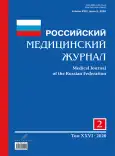Falls in the elderly due to vestibular dysfunction: clinical and pathogenetic aspects
- Authors: Damulin I.V.1,2, Tardov M.V.3
-
Affiliations:
- Medical Institute of Russian Peoples’ Friendship University
- I.M. Sechenov First Moscow State Medical University (Sechenov University)
- L.I. Sverzhevsky Research Institute of Clinical Otorhinolaryngology
- Issue: Vol 26, No 2 (2020)
- Pages: 98-103
- Section: Reviews
- URL: https://journals.rcsi.science/0869-2106/article/view/42550
- DOI: https://doi.org/10.18821/0869-2106-2020-26-2-98-103
- ID: 42550
Cite item
Abstract
This article discusses the clinical features and causes of falls in the elderly due to vestibular dysfunction. The sociomedical significance of this problem is emphasized. Almost 50% of older people who have suffered repeated falls have a restriction of physical activity because of psychological reasons (fear of repeated falls). The most common cause of falls is balance disorders, and the corresponding complaint in patients with falls is vertigo. The description of peripheral and central forms of vertigo is provided. The clinical and pathogenetic aspects of these disorders are considered. It emphasizes that research conducted in recent years using methods of functional neuroimaging has significantly advanced our understanding of the mechanisms of functioning of the vestibular system, especially its central parts. Based on the results of studies aimed at studying the human connectome in patients with cochleovestibular disorders, the significance of multimodal sensory integration disorders with this pathology is shown.
Keywords
Full Text
##article.viewOnOriginalSite##About the authors
I. V. Damulin
Medical Institute of Russian Peoples’ Friendship University; I.M. Sechenov First Moscow State Medical University (Sechenov University)
Author for correspondence.
Email: damulin@mmascience.ru
ORCID iD: 0000-0003-4826-5537
MD, PhD, DSc, Professor
Russian Federation, MoscowM. V. Tardov
L.I. Sverzhevsky Research Institute of Clinical Otorhinolaryngology
Email: mvtardov@rambler.ru
ORCID iD: 0000-0002-6673-5961
MD, PhD, DSc
Russian Federation, MoscowReferences
- Francis R.M. Falls and fractures. Age Ageing. 2001; 30(Suppl. 4): 25-8. doi: 10.1093/ageing/30.suppl_4.25.
- Tideiksaar R. Falls in older persons. In: Spivack B.S., ed. Evaluation and Management of Gait Disorders. New York: Marcel Dekker, Inc.; 1995: 243-66.
- Parry S.W., Steen N., Galloway S. et al. Falls and confidence related quality of life outcome measures in an older British cohort. Postgrad Med J. 2001; 77(904): 103-08. doi: 10.1136/pmj.77.904.103.
- Tinetti M.E. Preventing falls in elderly persons. N. Eng. J. Med. 2003; 348(1): 42-9. doi: 10.1056/NEJMcp020719.
- Godwin-Austen R., Bendal J. The Neurology of the Elderly. London: Springer-Verlag; 1990. 148 p.
- Rowland L.P. Falls in the elderly. In: Rowland L.P., ed. Merritt’s Neurology. 10th Ed. Philadelphia: Lippincott Williams & Wilkins; 2000: 953-4.
- Friedman S.M., Munoz B., West S.K., Rubin G.S., Fried L.P. Falls and fear of falling: which comes first? A longitudinal prediction model suggests strategies for primary and secondary prevention. J Am Geriatr Soc. 2002; 50(8): 1329-35. doi: 10.1046/j.1532-5415.2002.50352.x.
- Overstall P.W. Prevention of falls in the elderly. J Am Geriatr Soc. 1980; 28(11): 481-4. doi: 10.1111/j.1532-5415.1980.tb01125.x.
- Brandt T., Dieterich M., Strupp M. Vertigo and Dizziness: Common Complaints. London: Springer; 2005. 148 p.
- Bisdorff A.R., Staab J.P., Newman-Toker D.E. Overview of the international classification of vestibular disorders. Neurol Clin. 2015; 33(3): 541-50. doi: 10.1016/j.ncl.2015.04.010.
- Lee H. Isolated vascular vertigo. J Stroke. 2014; 16(3): 124-30. doi: 10.5853/jos.2014.16.3.124.
- Kattah J.C., Talkad A.V., Wang D.Z., Hsieh Y.H., Newman-Toker D.E. H.I.N.T.S. to diagnose stroke in the acute vestibular syndrome. Stroke. 2009; 40(11): 3504-10. doi: 10.1161/strokeaha.109.551234.
- Troost B.T. Dizziness and vertigo in vertebrobasilar disease. Part II. Central causes and vertebrobasilar disease. Stroke. 1980; 11(4): 413-5. doi: 10.1161/01.STR.11.4.413.
- Hong C.T., Lai Y.J., Chan J.L. Vertigo with an isolated lesion in brainstem vestibular nucleus and nerve. Neurology. 2010; 74(5): 437. doi: 10.1212/wnl.0b013e3181ccc746.
- Thomke F., Hopf H.C. Pontine lesions mimicking acute peripheral vestibulopathy. J Neurol Neurosurg Psychiatry. 1999; 66(3): 340-9. doi: 10.1136/jnnp.66.3.340.
- Arai M., Terakawa I. Central paroxysmal positional vertigo. Neurology. 2005; 64(7): 1284. doi: 10.1212/01.wnl.0000147466.46705.41.
- Helmchen C., Ye Z., Sprenger A., Munte T.F. Changes in resting-state fMRI in vestibular neuritis. Brain Struct Funct. 2013; 219(6): 1889-900. doi: 10.1007/s00429-013-0608-5.
- Zwergal A., Linn J., Xiong G., Brandt T., Strupp M., Jahn K. Aging of human supraspinal locomotor and postural control in fMRI. Neurobiol. Aging. 2012; 33(6): 1073-84. doi: 10.1016/j.neurobiolaging.2010.09.022.
- Goldberg G.M. Multisensory vestibular inputs: the vestibular system. In: Pfaff D.W., ed. Neuroscience in the 21st Century: From Basic to Clinical. New York: Springer; 2013: 883-929.
- Cullen K.E. Physiology of central pathways. In: Furman J.M., Lempert T., eds. Handbook of Clinical Neurology. Amsterdam: Elsevier; 2016: 17-40.
- Kirsch V., Keeser D., Hergenroeder T., Erat O., Ertl-Wagner B., Brandt T., Dieterich M. Structural and functional connectivity mapping of the vestibular circuitry from human brainstem to cortex. Brain Struct Funct. 2015; 221(3): 1291-308. doi: 10.1007/s00429-014-0971-x.
- Lopez C., Blanke O., Mast F.W. The human vestibular cortex revealed by coordinate-based activation likelihood estimation meta-analysis. Neuroscience. 2012; 212: 159-79. doi: 10.1016/j.neuroscience.2012.03.028.
- Boegle R., Cyran C.A.M., Stephan T., Dieterich M., Glasauer S. P34: Age-related decline in functional connectivity of the vestibular cortical network. Clin Neurophysiol. 2014; 125(Suppl. 1): S58. doi: 10.1016/s1388-2457(14)50198-8.
- Cyran C.A.M., Boegle R., Stephan T., Dieterich M., Glasauer S. Age-related decline in functional connectivity of the vestibular cortical network. Brain Struct Funct. 2015; 221(3): 1443-63. doi: 10.1007/s00429-014-0983-6.
Supplementary files






